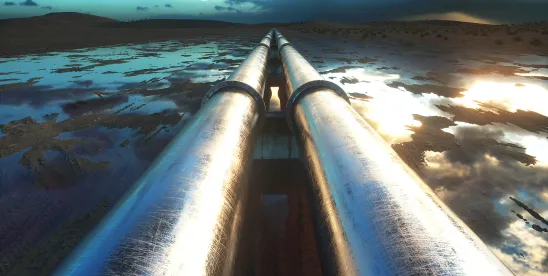On 16 August 2024, the D.C. Circuit Court of Appeals issued an opinion vacating portions of new natural gas-related pipeline-safety standards promulgated by the US Pipeline Hazardous Materials Safety Administration (PHMSA), that were part of a more than 10-year agency regulatory process to update its safety standards.1 The new rules were challenged by the Interstate Natural Gas Association of America (INGAA), the trade association for interstate natural gas pipeline companies. Ultimately, the court agreed with INGAA that PHMSA had failed to perform an adequate cost-benefit analysis of four of the proposed rules, a statutory requirement under 49 U.S.C. §§ 60102(b)(3) and (5).
The decision is particularly relevant for pipeline operators because the decision means that operators will not have to comply with the four vacated final rules. It also means that pipelines likely will delay implementing a number of these safety proposals, resulting in a delay in cost-of-service increases or imposition of surcharges on pipelines’ shippers. However, in light of ongoing frustration with PHMSA from members of Congress over perceived delays in updating safety and environmental standards, this is likely to increase pressure on the agency to resolve the issues identified by the court and further advance needed safety reforms.
BACKGROUND AND PHMSA’S COST-BENEFIT ANALYSIS
When PHMSA seeks to impose a new safety standard, the statute requires that the agency perform and publish two cost-benefit analyses: one when it first proposes the standard, and another when the rule is finalized.2 Before finalizing a rule, PHMSA must consider recommendations from the relevant advisory committee that provides peer review earlier in the process, comments and information received from the public, and other factors such as the reasonableness of the standard itself.3 PHMSA is also required to explicitly consider costs and benefits when issuing the final standard.4
In this case, PHMSA first published an Advance Notice of Proposed Rulemaking announcing its consideration of proposed changes to gas transmission pipelines in 2011. It was not until five years later in 2016, that the agency published a Notice of Proposed Rulemaking outlining many proposed changes to the pipeline safety standards and included a report that outlined the expected costs and benefits of the proposed standards. More than six years later, PHMSA promulgated its final rule in August 2022, including with the final rule its “Final Regulatory Impact Analysis,” which analyzed the costs and benefits of the new regulations. INGAA challenged five of the new regulations, arguing that PHMSA’s rulemaking process and final justifications were flawed.
COURT REJECTS FOUR NEW RULES FOR FAILURE TO PERFORM AN ADEQUATE COST-BENEFIT ANALYSIS
In reviewing PHMSA’s approach to the new regulations, the court agreed with INGAA on four of the standards (the high-frequency-ERW standard, the crack-MAOP standard, the dent-safety-factor standard, and the corrosive-constituent standard), finding that each of the standards were based on PHMSA’s inadequate final cost-benefit analyses. With regard to some of the new rules, the court found that PHMSA made only cursory statements about potential costs on the industry that were insufficient to constitute adequate consideration of the costs and benefits, and in other situations, PHMSA performed no cost-benefit analysis at all. As such, the court invalidated these four new regulations, sending PHMSA back to the drawing board on these critical pipeline safety issues. We provide more specific details about each of the four regulations and the court’s analysis below.
High-Frequency-ERW Standard
Traditional pipelines have been produced using low-frequency currents to perform welds, some more modern pipes are manufactured through the process known as electric resistance welding (ERW). Prior to this rulemaking, the regulations incorporated a version of industry safety standards known as ASME/ANSI B31.8S that required operators to repair a pipeline upon discovering metal loss along longitudinal seams formed by low-frequency ERW. The standards did not reference pipelines formed from high-frequency electric ERW.
PHMSA’s final rule imposed the same requirement for repair on both kinds of pipes. PHMSA did not recognize the requirement as “new” and therefore did not consider the costs to pipeline operators imposed in its analysis. However, the court disagreed with this interpretation, finding that this provision was in fact a new requirement that would necessitate the agency’s preparation of an additional cost-benefit analysis. Because the agency imposed a new safety requirement without properly addressing the cost of doing so, the court vacated the standard.
Crack-MAOP Standard
Cracks in a pipeline can potentially cause failures, and PHMSA’s new crack-MAOP standard sought to address when immediate repair of cracks by the operator would be required.
During the comment period, PHMSA adjusted the approach taken in the proposed rule, changing the requirement that operators immediately repair any anomaly in pipes when the predicted failure pressure was less than or equal to 1.1-times the maximum allowable operating pressure (MAOP). Instead, the final rule required the immediate repair for any crack or crack-like anomaly when the predicted failure is less than 1.25-times the MAOP. This new threshold increases the burden on operators, and PHMSA did not evaluate the costs specific to this change from the proposed rule to the final rule.
The court rejected PHMSA’s arguments that the standard was necessary for safety and that it was not obligated to consider these impacts separately, concluding that the standard must be vacated because of PHMSA’s failure to provide a reasoned cost-benefit analysis for the standard. On this last point, the court expressly declined to consider “the precise extent to which the agency must particularize its cost-benefit analyses, or the extent to which it can calculate the costs and benefits of related provisions together,” clearly leaving the issue open for a future determination.
Dent-Safety-Factor Standard
The dent-safety-factor standard helps operators determine whether certain dents in pipeline walls require immediate repair or if repairs can be delayed. The proposed rule included an exception to the typical requirements that would allow operators to avoid or delay repair when operators have performed an engineering analysis that demonstrates the pipe is not at risk of failure based on critical strain levels, an exception that the industry supported. A sub-provision added to the final rule, but not included in the proposed rule, spelled out procedures for when an operator seeks to utilize this exception to the normal repair requirements. Again, the court vacated the provision for its complete failure to analyze costs associated with the rule.
As for the remedy, INGAA requested that only the sub-provision be vacated while leaving the rest of this section intact. PHMSA argued that if vacated, the whole provision must be removed. The court sided with PHMSA, finding that only vacating the sub-provision would potentially allow operators to utilize the exception without having to comply with the sub-provision that details when the reassessment must take place. The court explained that it had substantial doubt that the agency would have adopted the provision without the subsection requirements and thus vacated the section in its entirety.
Corrosive-Constituent Standard
The fourth overturned regulation was the corrosive-constituent standard, which was designed to require operators to monitor and prevent internal corrosion of pipeline walls. Prior to the proposed rule, the regulations focused on corrosive gas. The present rulemaking sought to add specific language requiring operators to identify potentially corrosive constituents in gas being transported. In response to comments received during the rulemaking process, PHMSA changed this requirement in the final rule, instead requiring operators to develop and implement a monitoring and mitigation program to mitigate the corrosive effects, as necessary.
PHMSA’s analysis of the costs contained contradictory language, at some points claiming that there is no expected incremental compliance activities or costs and elsewhere acknowledging that there may be compliance costs. Due to this inconsistency, the court found that the agency’s final cost-benefit analysis failed to meet the requirement for a reasoned cost-benefit analysis. The court therefore vacated the provision.
CONCLUSION
We expect that PHMSA will make another attempt to advance these now-vacated regulations, as the agency views them as critical to pipeline safety. The agency will need to provide a clear statement of the cost-benefit analysis for each regulation to cure the errors highlighted by the D.C. Circuit.
In the meantime, PHMSA continues to advance other long-delayed updates to its safety regulations, including integrity management and leak detection regulations. These delays have prompted calls from both Republicans and Democrats for the agency to accelerate efforts to update its safety regulations. In January 2024, Rep. Jeff Duncan (R-SC), chairman of the U.S. House of Representatives’ Energy and Commerce Subcommittee on Energy, Climate, and Grid Security, expressed concern in a congressional hearing about the “numerous overdue Congressional mandates and open rulemakings that have yet to be finalized by PHMSA.” As recently as July, Sen. Martin Heinrich (D-NM) led 40 lawmakers in a letter to PHMSA highlighting that a rulemaking mandated by the bipartisan Protecting Our Infrastructure of Pipelines and Enhancing Safety Act of 2020 is “already far behind schedule” and urging PHMSA “to finalize, as soon as possible, the proposed protective standards to improve public safety and cut methane pollution from gas pipelines.” This bipartisan approbation will continue to push the agency toward finalizing required safety updates.
Pipeline operators and companies transporting natural gas should stay attune to additional developments from PHMSA and the congressional committees with jurisdiction over the agency. The firm's natural gas regulatory and public policy teams can assist companies working to understand impacts on their business.






 />i
/>i

